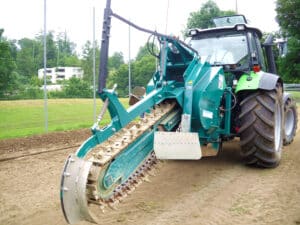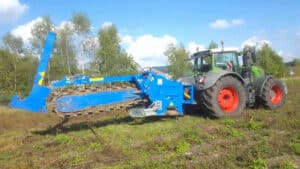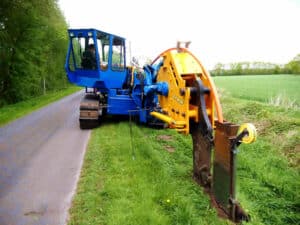In the field of urban planning, a trencher can be used in several ways. Similar to construction, the versatility here is very high. Here are some ways a trencher can be used in urban planning:
- Laying electricity, gas and water pipes: A trencher can be used to create trenches for laying power, gas and water lines. These trenches can help ensure that pipelines are installed safely and effectively, helping to improve infrastructure and the quality of life in the city.
- Street light installation: A trencher can also be used to create trenches for street light installation. These trenches can help ensure that lighting is installed safely and effectively, providing greater safety and comfort in the city.
- Installation of sewage systems: A trencher can also be used for the installation of sewage systems. These ditches can help drain wastewater effectively, providing better sanitation and health in the city.
- Creation of green areas: A trencher can also be used to create trenches for the creation of green areas. These trenches can help create green spaces safely and effectively, providing an improved environment and aesthetics in the city.
It is important that the trencher is selected according to the needs and requirements of the urban planning project and is operated by qualified professionals to ensure safe and efficient use.
Advantages of the trencher
A trencher can also be used in urban planning, offering a number of advantages, such as:
- Efficiency: A trencher can excavate large amounts of soil in a short time, which helps to speed up the process of urban planning. Rapid trenching can also facilitate the construction of roads and other infrastructure in urban areas.
- Precision work: a trencher is capable of digging trenches with high precision, which is an advantage when installing urban infrastructures such as gas pipes, water pipes, power cables, sewers or telecommunication lines. This allows for better planning and more precise trenching, reducing the risk of rework.
- Less damage to surrounding terrain: a trencher causes less damage to surrounding trees, plants and other terrain features than other excavation methods such as hand digging trenches. The machine is also capable of working in tighter areas, reducing the risk of damage to adjacent buildings or other structures.
- Improving work safety: using a trencher can improve work safety because the machine is able to remove materials in a controlled and safe manner. This reduces the risk of accidents and injuries that can occur with other excavation methods.
Examples of the use of a trencher in urban planning could include:
- Laying water and gas pipes
- Installation of power cables for the supply of city districts
- Construction of roads and sidewalks
- Laying of sewers for sewage disposal
- Laying of telecommunication lines for better connectivity in the city.

GM 1 AF trencher as tractor trencher
The GM 1 AF trencher from Lingener Baumaschinen is a powerful machine that can be used as a tractor trencher. It is ideal for use

GM 600 R – Milling wheel for cable construction
The GM 600 R milling wheel from Lingener Baumaschinen is a specialized tool for cable construction and the laying of lines and pipes. It can

GM 4 All-wheel drive – sports field drainage with the trencher
The GM4 4WD trencher from Lingener Baumaschinen is a powerful machine designed for sports field drainage. The machine has a powerful 4-cylinder diesel engine and

GM 4 Caterpillar – trencher for laying fiberglass
The GM 4 crawler trencher from Lingener Baumaschinen is a special machine designed for fiberglass laying. It is a tracked tiller ideal for use in

























































